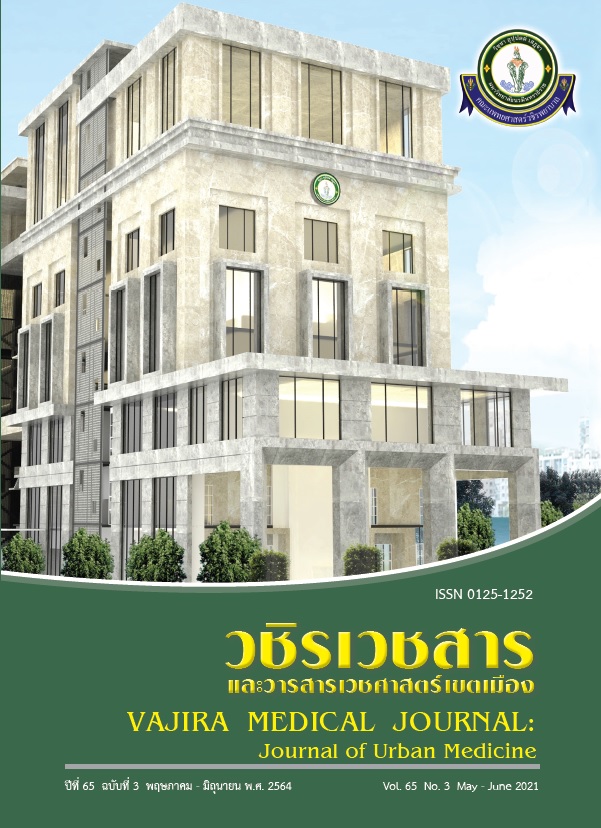Prevention and Management of the Diabetic Foot in the Diabetic Patients at the Health Promoting Hospital by the Family Medicine Physicians
Main Article Content
Abstract
Objective: To develop the prevention and the management of the diabetic foot in the diabetic patients at the 13-heath promoting hospitals in Banglamung disctrict, Chonburi province by assessing the activities about the diabetic foot,s patient examination by all the public health personnel in the health promoting hospitals. Then, brought the information obtained to analyze according to the standard health practical guideline and presented in the proper service organization to all of the health workers in the health promoting hospitals.
Methods: The study evaluated the activities about the diabetic foot, s patient examination (2,302 patients) by all the health workers of the 13 - health promoting hospitals in Banglamung istrict, Chonburi province in 2018. The data were analyzed and compared with the standard health practical guideline and adjusted the new guidelines according to the contexts of the health promoting hospitals.
Results: There are guidelines for the healthcare personnel to evaluate diabetes patients at the 13-health promoting hospitals for both prevention protocol and management guidelines of the diabetes foot,s patients. The report showed that these hospitals had an examination of all foot state 43.01 %, had the referral of the abnormal feet and wounds on the feet in order to get the right treatment, 2.12 % which originally did not find these informations at the 13 health promoting hospitals in the past.
Conclusion: This study is the initiation of the development of the prevention and the management of the diabetic foot in the diabetic patients for the public health personnels in order to comply with the contexts of the health promoting hospital.
Health risk assessment for preventing and managing in the diabetic foot, s patient, the family medicine physicians have a role of knowledge, skills and positive attitude toward them. As well as providing treatment, advice and organize a patient care system at the health promoting hospitals.
Downloads
Article Details
References
Rawdaree P, Ngarmukos C, Deerochanaworng C, Suwanwalaikorn S, Chetthakul T, Krittiyawong S, et al. Thailand diabetes registry (TDR) project: clinical status and long term vascular complications in diabetic patients. J Med Assoc Thai 2006;89 Suppl 1:S1-9.
Tantisiriwat N, Janchai S. Common foot problems in diabetic foot clinic. J Med Assoc Thai 2008; 91(7):1097-101.
Chusak T, Sasang N, Chaleoykitti S. Effect of diabetes foot care program to prevent leg cramps of type 2 diabetic patients, Samrongchai sub-district, Phisalee district, Nakhon Sawan province. Royal Thai Army Medical Journal 2018;71(2): 105-112.
Reewpaiboon A, Chatterjee S, Piyauthakit P. Cost analysis for efficient management: diabetes treatment at a public district hospital in Thailand. Int J Pharm Pract 2011;19:342-9.
Navichrerm R. Diabetes self-management, fasting blood sugar and quality of life among type 2 diabetic patients with foot ulcer. J Med Assoc Thai 2012;95:156-62.
Rerkasem K, Kosachunhanun N, Tongprasert S, Guntawongwan K. A multidisciplinary diabetic foot protocol at Chiang Mai University Hospital. Int J Low Extrem Wonds 2008;7:88-92.
Coordinators: Francisco Lozano and Albert Clará (SEACV). Members of ad hoc committee: Diego Alcalá (AEC); Albert Clará, José Ignacio Blanes, Esther Doiz, Rocío Merino, Francisco Lozano (SEACV); Juan González del Castillo (SEMES); José Barberán (SEMI); Rafael Zaragoza (SEMICYUC); and José Elías García Sánchez (SEQ). Consensus document on treatment of infections in diabetic foot. Rev Esp Quimioter 2011;24:233-62.
Kosachunhanun N, Tongprasert S, Rerkasem K. Diabetic foot problems in tertiary care diabetic clinic in Thailand. Int L Low Extrem Wonds 2012;11:124-7.
Boulton AJ.The pathogenesis of diabetic foot problems: an overview. Diabet Med 1996;13 Suppl 1:S12-6.
Besse JL, Leemrijse T, Deleu PA. Diabetic foot: the orthopedic surgery angle. Orthop Traumatol Surg Res 2011;97:314-29.
Wrobel JS. Najafi B. Diabetic foot biomechanics and gait dysfunction. J Diabetes Sci Technol 2010;4:833-45.
Sriussadaporn S, Mekanandha P, Vannasaeng S, Nitiyanant W, Komoltri C, Ploybutr S, et al. Factors associated with diabetic foot ulceration in Thailand: a case-control study. Diabet Med 1997;14:50-6.
Sriussadaporn S, Ploybutr S, Nitiyanant W, Vannasaeng S, Vichayanrat A. Behavior in selfcare of foot and foot ulcers in Thai non-insulin dependent diabetes mellitus. J Med Assoc Thai 1998;81:29-36.
Paritnonkaet A. The relationship factors which related the foot ulceration in the diabetes patients at the health promoting hospitals in Phra Padaeng district Samut Prakan province. Apheit international journal 2017; 56-67.
Rerkasem K. Seminar review: sociocultural practices and epidemiology of diabetic foot problem: lessons from a study in Chiang Mai University Hospital, Thailand. Int J Low Extrem Wound 2011;10:86-90.
Kosachunhanun N, Tongprasert S, Rerkasem K. Diabetic Foot Problems in Tertiary Care Diabetic in Thailand. Int J Low Extrem Wounds 2012;11:124-7.
Boulton AJ, Armstring DG, Albert SF, Frykberg RG, Hellman R, Kirkman MS, et al. Comprehensive foot examination and risk assessment: a report of the task force of the foot care interest group of the American Diabetes Association, with endorsement by the American Association of Clinical Endocrinologists. Diabetes Care 2008;31:1679-85.
International Working Group on the Diabetic foot. International Consensus on the Diabetic Foot and Practical Guidelibes on the Management and the Prevention of the Diabetic Foot [CD-ROM]. Amsterdam: the Netherlands; 2011.
Mazze R, Bergenstal RM, Cuddihy R, Strock ES, Criego A, Langer O et al. Staged Diabetes Management. 3rd ed. West Sussex:John Wiley & Sons; 2012.
Mclnnes A,Jeffcoate W, Vileikyte L, Game F, Lucas K , Higson N, et al. Foot care Education in patients with diabetes at low risk of complications: a consensus Statement. Diabet Med 2011;28:162-7.


